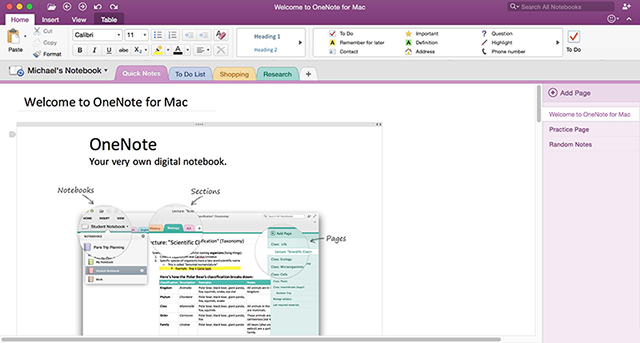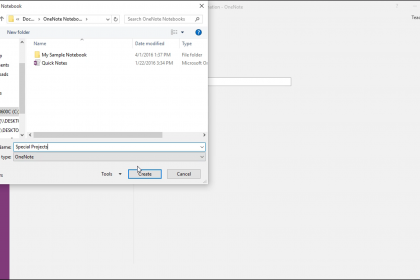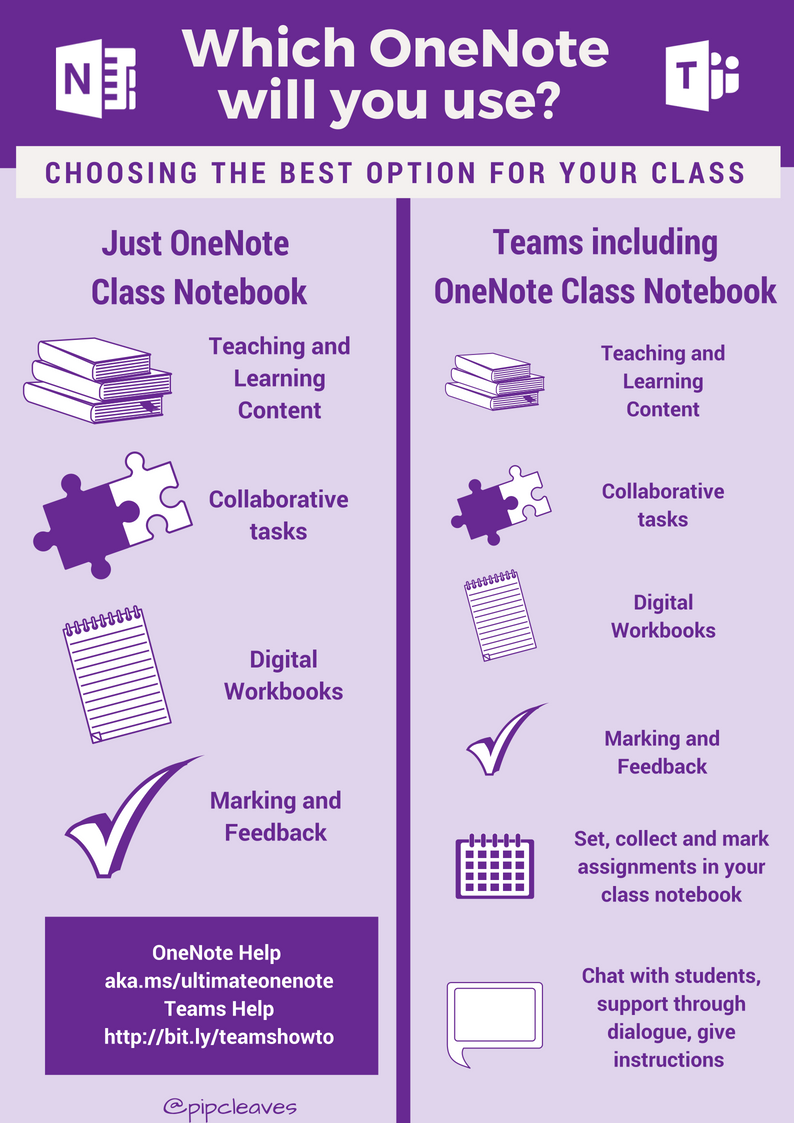The Class Notebook template in OneNote is a powerful collaborative tool that teachers can use with students to deliver and collaborate on class materials.
- Onenote New Notebook
- Onenote Unable To Create Notebook
- Open New Notebook Onenote
- Onenote Won't Let Me Create A New Notebook
- Onenote Will Not Let Me Create A New Notebook
- Onenote New Notebook Windows 10
To create a New Notebook in OneNote Online, using Office 365, use the following instructions:.NOTE: You will need to use the OneDrive for Business or the OneNote App, not the OneNote Online interface to create a new OneNote Notebook. Instructor A OneNote notebook can be set upwithin a Microsoft Team channel.I'm going to show you how to create this,as well as navigate your way around.So, to get started, we are alreadylogged in to Office 365 with the Teams app in view.We're working within the Marketing teamand we're going to be adding this OneNote notebookto the General channel within that. This new optional mode switches OneNote’s interface elements from light to dark — either as a color preference or as a functional benefit. Dark Mode can improve readability of your notes in low light environments, increase the legibility of the user interface, provide better contrast, and reduce eye strain. Install the new OneNote 2016 Class Notebook add-in - version 3.2.0.0. We just released a brand-new Class Notebook add-in update 3.2.0.0 for the OneNote 2016 Desktop app. This new add-in helps improve reliability and performance of page distribution and fixes a few known bugs. We encourage all educators to install this new update as soon as they.
Each Student can access the Class notebook with a personal section (the teacher can also access) for taking their own class notes and completing tasks. Instead of handing out photocopies the teacher can distribute new notebook pages to each student.
OneNote is available for Windows, Mac, tablets and mobiles. Microsoft’s main education support page can be found here
This is a guide on working well with OneNote Class notebook. During a time where online services are under such a heavy load it is important to educate the people using these online applications in best technical practise.
- OneNote for iOS (turn off Auto-Sync attachments in app settings)
- OneNote for Android (turn off Auto-Sync attachments in app settings)
Active relates to the application you are using.
- Keep OneNote active / do not minimise OneNote – While the Notebook is syncing or content is being distributed, both students and teachers need to keep OneNote open and active until all content is synced.
- Stay connected – The device that is using the Notebook needs to stay connected to the network while the sync process is occurring.
- Simply close OneNote when finished – Do not close the Notebook within OneNote as this will force an initial sync the next time the Notebook is opened, simply close the OneNote application instead of opening and closing individual notebooks.
- Use the Notebook created in your Class Teams – If your school is using SDS created Class Teams then for each class timetabled in the school’s administration system a Class Team will be created. Use the Class Notebook created by the Class Team.
- New students and teachers timetabled to a class will automatically be added to their relevant Class Team/s and the associated Notebooks. Note: If the Class Notebook is created by the Teacher – not SDS it:
- will not automatically bring in new timetabled staff and students,
- will not be stored in the correct location,
- will be lost if the staff member who created it is no longer with your Education organisation.
- will not be accessible by anyone else at the school unless that teacher has added them
- One Notebook per class (~30 students) – Avoid adding multiple classes to a Class Notebook as increasing the number of students, increases the size of the notebook and its ability to sync in a timely manner.
- Use the Teacher only section – By default the Teacher only section is not turned on for Class Notebooks. To turn this feature on go to the Class Notebook settings within Teams.
- Content added in Teacher-only section is not seen by students or synced down to their devices.
- Store course content here (following best practice for creating content) and then move it across to the Content and Collaboration sections as needed.
- If course content is extensive, it removes the need for a significant initial sync on student devices.
- Use the default student sections – teachers can create additional student sections or rename the default sections when initially setting up the notebook. However, please avoid creating section groups within student sections as this causes issue with the distribution of pages.
- Allow time for an initial sync – A new Class Notebook will have all new sections and new students and therefore will need time to perform an initial sync.
- Keep OneNote active – refer to the previous point.

Note: A new student to the class should allow enough time for the first initial sync to occur. This time will vary based on the size and number of notebooks that need to sync.
Planning is key to improve optimal use of Class Notebooks, as new sections and large content are added it will take time for the Class Notebook to sync.
- Plan ahead – plan the new content sections that need to be created.
- Create new sections ahead of time – create new sections the day before.
- Sync – When a new section is created the teacher should perform a manual sync to ensure the new section is available before class.
- Students need to sync – If new sections have been created and synced by the teacher, please ask at the beginning of class for students to perform a manual sync.
Note: New Pages do not need a manual sync if they are created in an existing section and students have previously had a successful sync.
Inserting/attaching/embedding large files such as PDF’s, word documents, videos etc will slow down the syncing process and distribution of content to students as this increases the size of the page and the Class Notebook as a whole.
- Create page in an existing section – new sections take longer to sync, therefore for those times when you need to create content during a class, try to create the page in an existing section to reduce the sync times.
- Choose the best way to add your content:
Within OneNote there are many acceptable ways to add content onto a OneNote page. However, some methods encourage a timelier ‘sync’ for your students.
- Create content directly on the page – type or copy and paste material directly into a Class Notebook page instead of embedding the file or linking to it.
- Embed Sway or stream video – Teachers can embed a Sway or stream video as the content lives elsewhere as only being linked.
- Link files instead – If you cannot create the content directly in a page, upload your file/s to the Class Site in Class Teams (or in a location that students can still access) before linking it to a OneNote page. Links can be used by adding a hyperlink to the file.
- Adding files as attachments in small numbers – Be aware of using your Class Notebook as file storage, this can lead to the Class Notebook becoming very large and can cause issues with syncing.
- Embed as a last resort – Avoid embedding large files – this includes PDFs, large or complicated Word documents with lots of images or tables etc as this typically increases the size of the page and therefore the Notebook which will slow the syncing and page distribution process down.
- Reduce Image size – before embedding an image in a Class Notebook, reduce the size of the image to approximately <1MB.
When a page is distributed to a student’s section, it takes a copy of the page and places it in the student’s section. This process electronically replicates photocopying a handout and giving a copy to each student.
Where possible, distribute pages ahead of time. Crack autocad 2019 mac. This is especially important if the page to be distributed is heavy (includes images or attachments) and/or if the class size is larger than 25 students.
- Plan ahead – distribute the page ahead of time where practical
- Only distribute the content you need – Distribute the pages you need for the next lesson from your Content Library so that your students’ devices sync quickly.
- Monitor the distribution progress – when the page has been distributed, monitor its progress using the distribution panel (do not close this panel until distribution indicates “Done”)
- Do not distribute the same page multiple times – Attempting to distribute the same page again will create duplicate copies of the same page and cause confusion among students.
- Do not ask the student to go and copy a page you have already distributed as it will result in multiple copies.
In all instances of troubleshooting OneNote for either the teacher or the student, please ensure OneNote is open and is not minimised, in other words keep OneNote active.
Use the Notebook Navigation pane to confirm if the Notebook is still syncing.
Microsoft provide a number of troubleshooting tips here – Microsoft Onenote troubleshooting guide
- Student – Allow the Class Notebook to perform a full initial sync – this will take time depending on the Class Notebook size.
- Student – If after 5-10 mins the notebook has not synced or starting to display content, please restart the app.
- Teacher – Perform a manual sync to see the newly created student’s notebook.
- New Teacher – Allow the Class Notebook to perform a full initial sync – this will take time depending on the Class Notebook size and the number of students in the class.
- New Teacher – If after 5-10 mins the notebook has not synced or starting to display content, please restart the app.
- Open the Class Notebook in the OneNote app
- Sync the notebook – keep the app open until sync is complete
- right click the student section to delete and choose delete
- Sync the notebook – keep the app open until sync is complete
- Distribute a Test Page to students – confirm the Deleted Student section doesnt return
- Delete the Distributed Test page from student notebooks and sync notebook
- Teacher – Open the Class Notebook online and confirm the content has synced up from the teacher’s device.
- Teacher – If the content is not online, perform a manual sync.
- Student – Once Teacher’s sync is complete, perform a manual sync.
- Teacher – Has the sync or page distribution process completed on the Teachers device?
- Student – Close OneNote and reopen.
- Student – If student has not performed manual sync after teacher created a new section, please do so.
- Student – check if the Class Notebook is syncing, if it is, let the sync continue.
- Student – If the Class Notebook is not syncing, perform a manual sync.
- Teacher – confirm page distribution completed successfully (Do not redistribute as this will create a duplicate page).
- Student – Close OneNote and reopen.
- Student – check if the Class Notebook is syncing, if it is, let the sync continue. Page distribution should occur within 5 minutes of the process completing on the teacher’s device.
- Student – If the Class Notebook is not syncing or content is not visible after a completed automatic sync, perform a manual sync.
- this issue occurs when the student has “saved” the page from the content or collaboration section or when
- the Teacher has distributed the page twice.
- The only way to resolve the duplicate pages is for the teacher to go into each student’s section and remove the duplicate page.
Turn off Auto Sync Attachments on your iPad by navigating to the Sync page in your OneNote settings. All text and ink content will still sync automatically, but OneNote pages with rich content like images and PDFs will wait to sync until you visit the page. After that, the page you visited will begin syncing automatically.
How to – Confirm app is syncing
- In the top left hand corner open the Notebook Navigation pane
- Check the Notebook name for the sync icon.
How to – Perform a Manual notebook Sync (Windows & MacOS)
- In the top left hand corner open the Notebook Navigation pane
- Right Click on the Notebook and click on ‘Sync’.
- Click on ‘Sync This Notebook’.
How to – Distribute Class Notebook page to all students in the class
- Before the class, open the Class Notebook you’d like to distribute from in OneNote.
- Select the page you want to distribute in your Notebook’s Content Library.
- Select the Class Notebook tab, then select Distribute Page.
- Choose the Notebook section you’d like the page copied to. For example: Class Notes. All students will get a copy of the page in their Notebook’s Class Notes section. Click on ‘Distribute’.
- Wait until it distributes the page.
Original Content – Brisbane Catholic Education
Related posts:
 © 10'000 Hours/Getty Images OneNote, the digital note-taking platform from Microsoft, can streamline your workflow and keep all your projects organized. 10'000 Hours/Getty Images
© 10'000 Hours/Getty Images OneNote, the digital note-taking platform from Microsoft, can streamline your workflow and keep all your projects organized. 10'000 Hours/Getty Images - You can organize your notes for work, school, and home with Microsoft's OneNote program.
- OneNote lets you create multiple notebooks, pages, and sections to organize your notes in.
- Visit Insider's Tech Reference library for more stories.
OneNote is a Microsoft program that's like a virtual planner, legal pad, and three-ring binder all rolled into one. It helps keep your thoughts and ideas orderly, categorized, and easily accessible.
To get the most out of OneNote, you'll want a good grasp on how to create and edit its pages, sections, and notes features.
Here's how you can get started organizing your notes with OneNote to take full advantage of the program's organization-oriented interface.
How to organize notes with Microsoft OneNote
You can create multiple hyper-organized notebooks to track different aspects of one project, or create a single broadly themed notebook to track all of your school, work, and personal projects in one place.
How to create a notebook in OneNote

However you decide to organize your notes is up to you, and whatever you decide, you'll get started by creating a notebook.
To create a notebook, open OneNote and navigate to 'File,' then select 'New Notebook..'
© Emma Witman/Business Insider You can leave your other notebooks open in OneNote while editing another notebook, or creating a new notebook. Emma Witman/Business Insider- Choose a notebook color, name your notebook, and then click 'Create.' You will always save your notebook in OneDrive, in order to support OneNote's synching mechanism.
How to create and edit sections in OneNote
The next organizational tier within OneNote is sections, which you add and edit for your notebooks.
- When you create a new notebook, the first section will automatically be created for you, and named 'New Section 1.' You can rename the section by right-clicking and selecting 'Rename.'
- You can also right-click to delete a section, and OneNote will double-check that you're sure before deletion, so that you don't accidentally lose anything.
To add another section, click 'Add section' at the bottom left of the screen. You can rename a new section right away.
How to create and edit pages in OneNote
Similar to how a notebook automatically creates a first section, a section will automatically spawn its first page.
The page name will default to 'Untitled Page' until you start adding notes or a header to the page. Kris hagerman. You can also right-click and add a name of your choosing to the page, rather than stick with the automatic title based on the contents of the page.
© Emma Witman/Business Insider To add a header to the page, right-click in the header section. Emma Witman/Business InsiderHow to create and edit subpages in OneNote

Bullet journal in evernote. Then, there's an even smaller organizational unit in OneNote: the subpage.
Onenote New Notebook
© Emma Witman/Business Insider You can even add subpages within subpages, if you'd like a particularly micro-organized OneNote notebook. Emma Witman/Business InsiderOnenote Unable To Create Notebook
A subpage will be beneath a page, but slightly indented. Right-click on an existing page and select 'Make Subpage' to make this change to the visual format.
How to create and edit notes in OneNote
Finally, there's the namesake 'note' aspect of OneNote.
Open New Notebook Onenote

Clicking anywhere on the page will create your first note.
© Emma Witman/Business Insider You can tap anywhere on the page to create your first note. Emma Witman/Business Insider- To edit an existing note, simply click near the text to highlight its text box and make edits.
To create a new, independent note, click far away on the page from the existing note.
Onenote Won't Let Me Create A New Notebook
If you reach a point where you want to remove a notebook you no longer need, and reduce clutter in OneNote, you can right-click on the notebook and select 'Close This Notebook.'
© Emma Witman/Business Insider Closing the notebook will remove it from view, but won't delete the file itself, which must be done in OneDrive. Emma Witman/Business InsiderOnenote Will Not Let Me Create A New Notebook
For a more permanent removal, you'll need to find and delete the notebook in OneDrive or on your computer.
Onenote New Notebook Windows 10
How to print from Microsoft OneNote and create hard copies of a section, page, or entire notebookHow to share a Microsoft OneNote notebook on a Mac or PC to collaborate with othersHow to update Microsoft OneNote on your PC in 5 steps, and keep the program running smoothlyHow to sync Microsoft OneNote notebooks on a Windows PC and keep your work up-to-date across devices